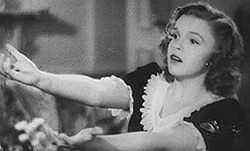Part of Winter 2000
Like on a tour of the horror house in a wax museum, Austrian filmmaker Martin Arnold escorts us through his renowned collection of award-winning films. With a keen eye for the macabre, Arnold selects minute scenes from Hollywood’s “dream factory” – from such classics as To Kill A Mockingbird and High Noon – and repeatedly replays, back and forth, the single frames. These “compulsive repetitions” create a visual whirligig, draining the scene of its original meaning and creating a surreal and often deeply disturbing suggestion. “Hollywood cinema is a cinema of exclusion, denial, and repression. I inscribe a symptom into it, which brings some of the aspects of repression to the surface, or, to say it in more modest words, which gives an idea of how, behind the intact world being represented, another not-at-all intact world is lurking.” Martin Arnold was born 1959 in Vienna. Studied Psychology and Art History at Vienna University. Freelance filmmaker since 1988. 1995 Visiting Professor at the University of Wisconsin in Milwaukee, 1996-97 Visiting Professor at the San Francisco Art Institute, 1998/99 Guest Professor at the Academy of Fine Arts in Frankfurt.
Programme:
pièce touchée 16mm, b/w, 16:00 min., 1989
Jesus Walking on Screen 35mm, b/w, 1:00 min., 1993 (trailer for a film series)
passage à l’acte 16mm, b/w, 12:00 min., 1993
Don’t: Der Österreichfilm 35mm, b/w, 3:00 min., 1996 (commissioned for the 100 years of cinema celebrations in Vienna)
Alone. Life Wastes Andy Hardy 16mm, b/w, 15:00 min., 1998
Psycho (Viennale Spot ’97) 35mm, b/w, 1:00 min., 1997 (trailer for Viennale Film Festival)
Akira M. Lippit: Martin Arnold’s Memory Machine (from Afterimage).
Arnold has constructed, in his films pièce touchée (1989), passage à l’acte (1993) and Alone. Life Wastes Andy Hardy (1998), a cinema machine – not simply a custom optical printer or recycling system, but a kind of mnemographic machine, an apparatus that writes and rewrites memories on the surfaces of film. Arnold’s cinema, however, is not a smooth machine. The breakdowns, short-circuits and gasps that define his cinema create a violently neurotic machine. Arnold´s machine stutters and twitches from the moment it is turned on. This is due, in part, to the fact that Arnold’s cinema barely holds together under the strain of a constant tension between its elements. It is a machine that thematizes even as it reproduces the scene of its own breakdown, obsessively and compulsively.
